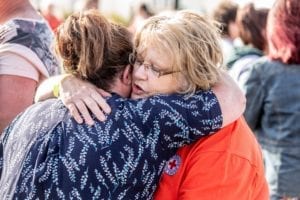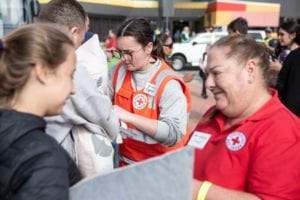Ian Willis
Camden, NSW, Austalia

“There were a lot of people who had lost everything,” said Australian Red Cross volunteer Tracey Ayrton, who has been providing comfort to bushfire victims at the Laurieton evacuation centre in northern New South Wales. Tracey, who has taken time off work, has been volunteering for over ten years. She says, “The reason why I’m a Red Cross volunteer is the empathy we can show people.”1
Women like Tracey have undertaken Red Cross humanitarian relief work for decades and have been the backbone of the Red Cross Movement. They freely provide their time and effort to create a safe and caring place for disaster victims at a point of crisis in their lives. They patiently listen to stories, show empathy, and provide relief assistance to ease pain, suffering, and trauma.

What is often overlooked is that the Red Cross also bestows benefits on its predominantly female workforce. This understated achievement of the Red Cross is missed by many. Historically the Red Cross has created opportunities for women that were otherwise denied to them in wider society. The role of female Red Cross workers is deeply embedded in the past and psyche of the organization.
The founder of the Red Cross in Australia, the formidable Lady Helen Munro Ferguson, understood this process. Munro Ferguson was the wife of the Australian Governor General and part of the British elite. She understood the opportunities the Red Cross could provide for Australian women from her extensive work with the Scottish branch of the British Red Cross Society.2
She took her lead from her British peers. This position was neatly summarized by Queen Alexandra, who led the reformed British Red Cross in 1905, when she said that Red Cross “was essentially a women’s work.” Historian Melanie Oppenheimer argues that Munro Ferguson felt that women in British society had “obligations within the public sphere” around social work and philanthropy. Munro Ferguson felt that:
“Female citizenship rested on the active participation of women within their own communities. . . . It was through philanthropy that women could achieve their goals, and this was the natural alternative to politics.”3
For Munro Ferguson the Red Cross was an effective vehicle to undertake this work. Women were mothers and wives, and the Red Cross was linked to the Victorian and Edwardian ideology of motherhood. The Red Cross portrayed itself as the metaphorical mother figure and ministering angel to sick and wounded soldiers. Historian Margaret Tennant argues that this was reinforced by nineteenth century British symbolism that linked the care of sick and wounded soldiers with the imagery of “The Lady with the Lamp” Florence Nightingale and the Crimean War, as much as it was to the Battle of Solferino and Henri Dunant.5
Under Munro Ferguson’s leadership thousands of Australian women embraced and joined the Red Cross at the outbreak the First World War. The Red Cross encapsulated their cultural values and traditions represented by Britishness, patriotism, service, and Christian charity in locations across Australia.
The Red Cross had a structure that allowed women to create safe spaces for themselves within the organization. Here women exercised their social and political agency away from the gaze of men who controlled the patriarchal social order of the day. The spaces that the women created within the Red Cross were all-female committees, working bees, sewing bees, fundraising committees, local branches, and a host of other groups that excluded men. Here women could openly discuss, in an unfiltered manner, women’s issues and problems without male company. The Red Cross was not the only organization to have done this, but it was one of few humanitarian organizations in Australia that had the care of the soldier as its central aim, led by a formidable British woman.
Munro Ferguson understood how the new Red Cross could benefit women of all classes as a political expression of their humanity. Based on her experience in Scotland and Queen Alexandra’s lead, she expressly targeted women in her recruitment literature and said that the Red Cross was the “best field of activity . . . for women” to express their patriotism.6 The Red Cross allowed women to undertake active citizenship and fulfill a wartime desire for patriotic duty towards their country. Australian women exercised active citizenship using skills developed in the private domestic sphere at Red Cross activities. Red Cross voluntary work functioned within the tight familial and personal contact networks of small closed communities that did not challenge patriarchy, gender expectations, class, conservatism, or Protestantism.
The weekly meeting of the local Red Cross branch in country towns and villages across Australia was an important event in the lives of rural women. The local Red Cross was an expression of political agency through voluntary activism in place. The Red Cross empowered women to create their own social spaces, and gain considerable social authority and kudos around patriotic wartime work that had a national agenda. That was a considerable achievement.
Red Cross knitting and sewing groups where women made hospital supplies were what historian Hilary M. Cary called “female collectivism.” Here women undertook “collective action as a force for change” that benefited their own communities.7 Red Cross work fitted the bill perfectly.
Red Cross relief work was an expensive business. Women created highly effective fundraising committees to achieve their goals. They raised huge sums of money to support soldier welfare and demonstrated a range of skills from marketing to budgeting and management skills. They excelled at all of it.
Some women wanted to directly serve by assisting sick and wounded soldiers, and they achieved this by becoming a voluntary aid. This was flagged by Munro Ferguson in 1914 and was done in conjunction with the Order of St John. The role of Voluntary Aid Detachments was linked to the military and the nursing profession, and had originally been started by the British War Office in 1909 and then spread out through the Empire. Groundbreaking work was undertaken by voluntary aids as they staffed the extensive network of Red Cross convalescent and repatriation homes and hospitals in Australia, New Zealand, and Great Britain.
During the First World War, Red Cross workers stepped up and did groundbreaking work at home in Australia. These women filled gaps where others failed to act towards soldier welfare. New South Wales Red Cross volunteer Isabelle Wallace Turner, the president of the Greenwich Red Cross in Sydney, organized homestays for medical evacuees amongst the troops from the New Guinea expeditionary force in 1914, and filled the gaps at the Liverpool Military Field Hospital with relief supplies when military medical authorities failed to do so in the early months of 1915.8
Formidable women have always played a number of roles in Red Cross history. One of these women was Dr. Lucy Bryce, from the Royal Melbourne Hospital. She was integral to the founding of the blood transfusion service in 1929 in Victoria. Based on the Greater London transfusion service set up by the British Red Cross Society in 1926,9 in Australia it operated on a state divisional basis. The service came under national control in 1996 after the crisis caused by HIV/AIDS, a change that met with stiff resistance from state divisions.
Red Cross workers themselves and others have seemed reluctant to acknowledge these considerable achievements. They have remained hidden in the shadows and the reasons are complex. Women have accepted the status quo and have not the been the best advocates for themselves and their work. They have been reluctant to tell their Red Cross stories.
Second World War Red Cross worker Betty Beering O’Neill said, “Everyone worked hard to care for the wounded and sick, mucking in and doing what we could . . . it wasn’t anything special.”10 These women were self-effacing and stoic, like Red Cross worker Tracey. They have maintained that their Red Cross work was not important and therefore did not need any special recognition. These achievements by the Red Cross and its voluntary workers are an example of exceptional efforts in extra-ordinary circumstances.
End notes
- Australian Red Cross, ‘Red Cross volunteers in the heart of bushfire country’. ARCS. Online at https://www.redcross.org.au/stories/emergency-services/volunteers-in-the-heart-of-bushfire-country viewed 8 January 2020.
- Melanie Oppenheimer. “The best P.M. for the empire in war’?: Lady Helen Munro Ferguson and the Australian Red Cross Society, 1914–1920.’ Australian Historical Studies 33:119 (2002), 114. http://dx.doi.org/10.1080/10314610208596204
- Oppenheimer, ‘The best PM’, 114
- Ian Willis, Ministering Angels The Camden District Red Cross 1914-1945. Camden: Camden Historical Society, 2014, 6. Online at https://www.academia.edu/41478013/Ministering_Angels_The_Camden_District_Red_Cross_1914-1945
- [1] Margaret Tennant, Across the Street, Across the World: A History of the Red Cross in New Zealand 1915-2015. Wellington, New Zealand Red Cross, 2015, 24.
- Quoted in Willis, Ministering Angels, 115.
- Hilary M Cary, “Doing Their Bit”: Female Collectivism And Traditional Women In Post-Suffrage New South Wales.’ Journal Of Interdisciplinary Gender Studies 1, 1 no 2 (1996): 106.
- Ian Willis, ‘The Red Cross and the Liverpool Field Hospital, Hope and Despair during 1915.’ Health and History 18, No. 1 (2016): 22-41. DOI: 10.5401/healthhist.18.1.0022
- Melanie Oppenheimer, The Power of Humanity 100 Years of Australian Red Cross 1914-2014. Melbourne: HarperCollins, 2014, 77.
- Quoted in Willis, Ministering Angels, 4.
IAN WILLIS, PhD, is an honorary fellow at the University of Wollongong, and a member of a number of professional historical organizations. He has a particular interest in the Australian Red Cross, local studies, and the war at home.
Submitted for the 2019–2020 Blood Writing Contest

Leave a Reply